I recently watched all four seasons of Black Sails, the pirate soap opera series that announced Starz‘s entry into prestige TV.
I have A Lot of Thoughts About This Show, which I’ll likely cover in several different posts — like this one, which analyzes the show’s various character arcs.
But today, I want to discuss what is (for me) the show’s defining trait: Black Sails is a perfect example of how to use consequences drive a plot relentlessly forward.
This is especially crucial in a story about pirates, where each character is torn between doing what’s “right” and doing what they can get away with in pursuit of their deeper desires. If those choices don’t have consequences, then the plot won’t have real stakes. But in Black Sails, even seemingly incidental choices often have massive ripple effects that affect every character on the show.
That’s because, just like pirates themselves, consequences are are unpredictable and uncontrollable. And when a show’s plot is as tightly wound as Black Sails is, the ultimate result of all those consequences feels inevitable.
Unlike, say… this show.
Perhaps the most impressive aspect of the way Black Sails navigates consequences is that every character’s end point feels logically, emotionally, and thematically appropriate.
Let’s take a quick look at how Black Sails came to be. Then I’ll show you why the main character of Captain Flint (played by Toby Stephens) is one of the best-written characters on any TV series this century.
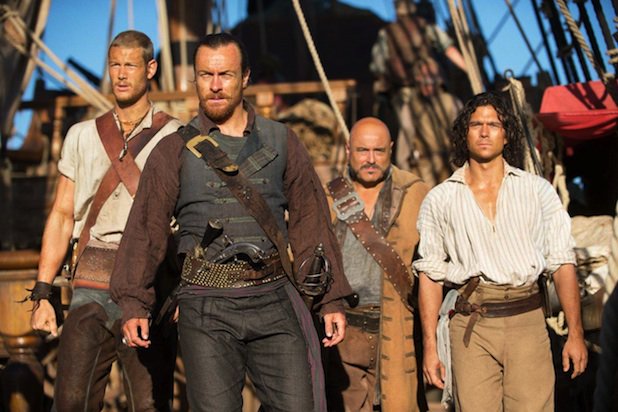
#squadgoals
On the Account
Black Sails is often compared to Game of Thrones and Vikings in the niche genre of costume action-dramas. As a fast-paced tale of double-crossing pirates, sweeping sea battles, heaving bosoms and high production values, Black Sails offers all the sex, violence, intrigue, and moral ambiguity you can squeeze into a corset, or a prestige scripted drama.
Under different circumstances, the show would likely have won more than just the few technical Emmys it picked up in its first season. It might even have become a cultural touchstone.
Unfortunately, Black Sails had two factors working against it that kept it from becoming a breakout hit.
First, it aired on Starz, which meant its ratings and pop culture potential already had a low ceiling.
Yes, Starz is definitely turning a corner with the quality of their original programs — like Outlander, which feels more and more like the show we need right now. But even the network’s big hits don’t yet have the same magnetic effect on viewers as the flagship shows from other networks do.
Case in point: while Black Sails debuted to a weekend audience of 2.6 million in 2014 (at that time the highest ratings yet for a Starz series debut), it only averaged 3.6M viewers per episode across all streams in its first three seasons. At the same time, The Walking Dead was attracting 13.3M viewers per week, which is almost four times the audience. There’s a reason Twitter is filled with TWD and GoT memes while the best Black Sails moments went largely un-GIFed.
It takes a true standout experience to get new viewers to order a premium cable channel they’re not already paying for… and that brings us to Black Sails‘s second problem: the comparison trap.
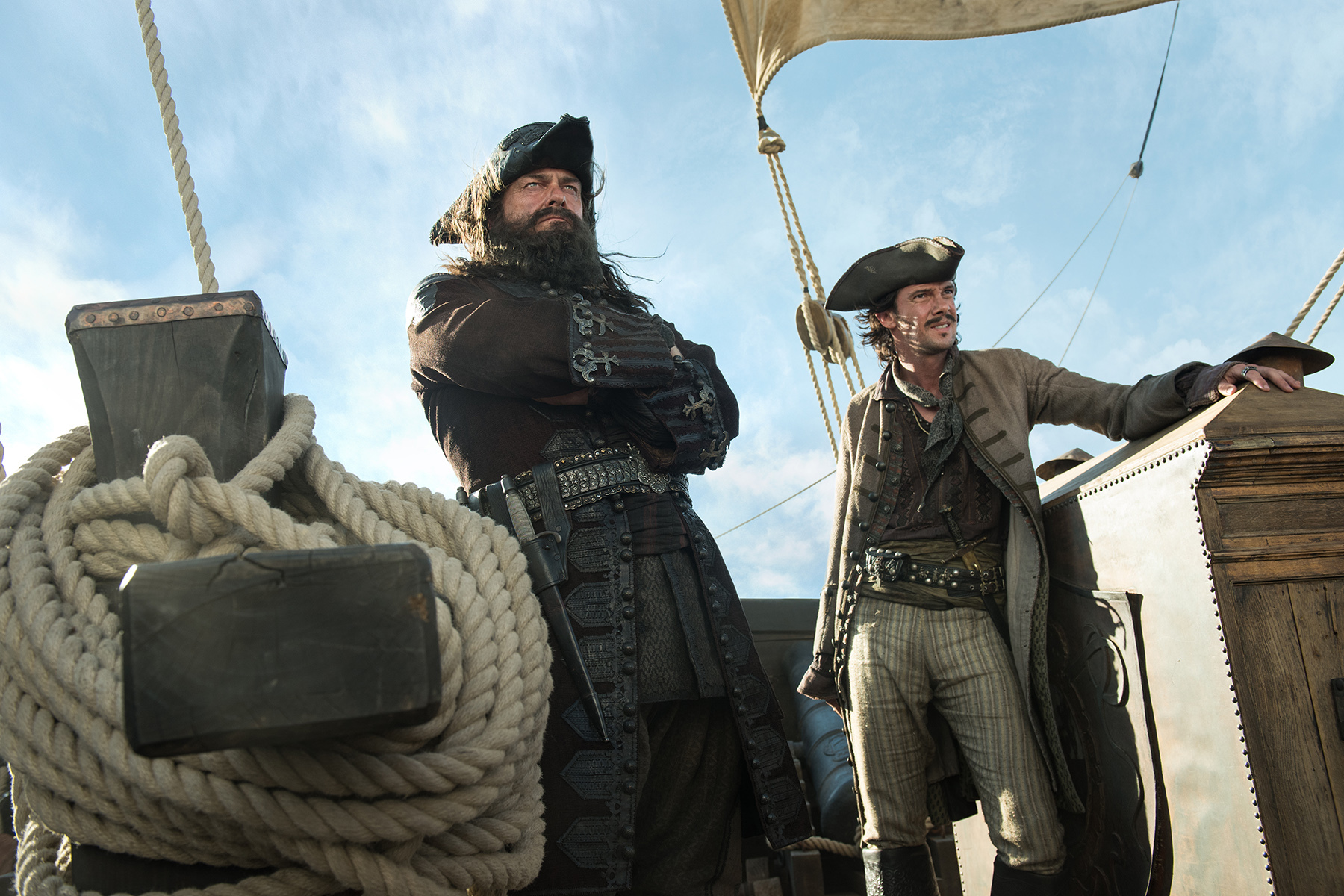
Blackbeard vs. Jack Rackham: Who wore it better?
If you want to see troubled men behaving badly, there were already a dozen better-known shows earning those headlines when Black Sails debuted in January of 2014. Breaking Bad had just wrapped, Mad Men was headed toward its conclusion, Game of Thrones was about to air its fourth season, and The Walking Dead was a nationwide ratings champion.
It’s darkly ironic that the only TV environment in which Black Sails could possibly have been made created a clogged market that prevented it from truly thriving.
But in a way, maybe that was for the best.
After all, Black Sails is the story of a man who was way ahead of his time. And it’s also a story we sort of know the ending to already… or do we?
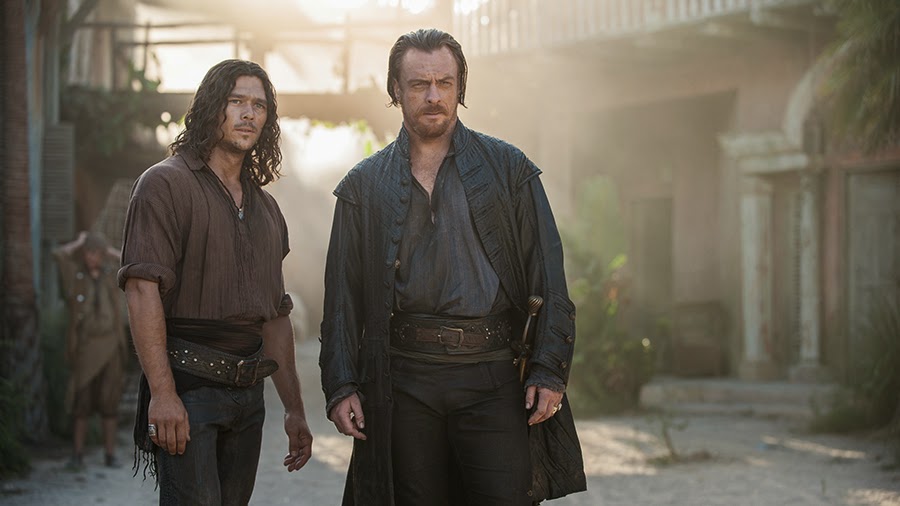
If you ain’t dirty, you ain’t here to party
Before John Silver Got Long…
Sure, a show about pirates could be interesting, but this show has a second layer:
Black Sails is a prequel to Treasure Island.
Robert Louis Stevenson’s iconic tale of Long John Silver and his pirate crew searching for Captain Flint’s buried treasure was first published in 1882. Since then, there have been plenty of retellings and adaptations, but no one had delved too deeply into the characters’ backstories… until now.
Black Sails showrunners Jonathan Steinberg and Robert Levine (who previously worked together on Human Target) envisioned their show as the lead-up to Treasure Island, in which we’d learn all about the relationship between the terrifying Captain Flint and his foil, Long John Silver. But they also wanted to ensure that their story was grounded in reality, so they included a bonus twist: in Black Sails, fictional characters like Flint and Silver share the screen with real-life historical figures from the golden age of piracy, like Charles Vane, “Calico” Jack Rackham, Anne Bonny, Woodes Rogers, and Blackbeard.
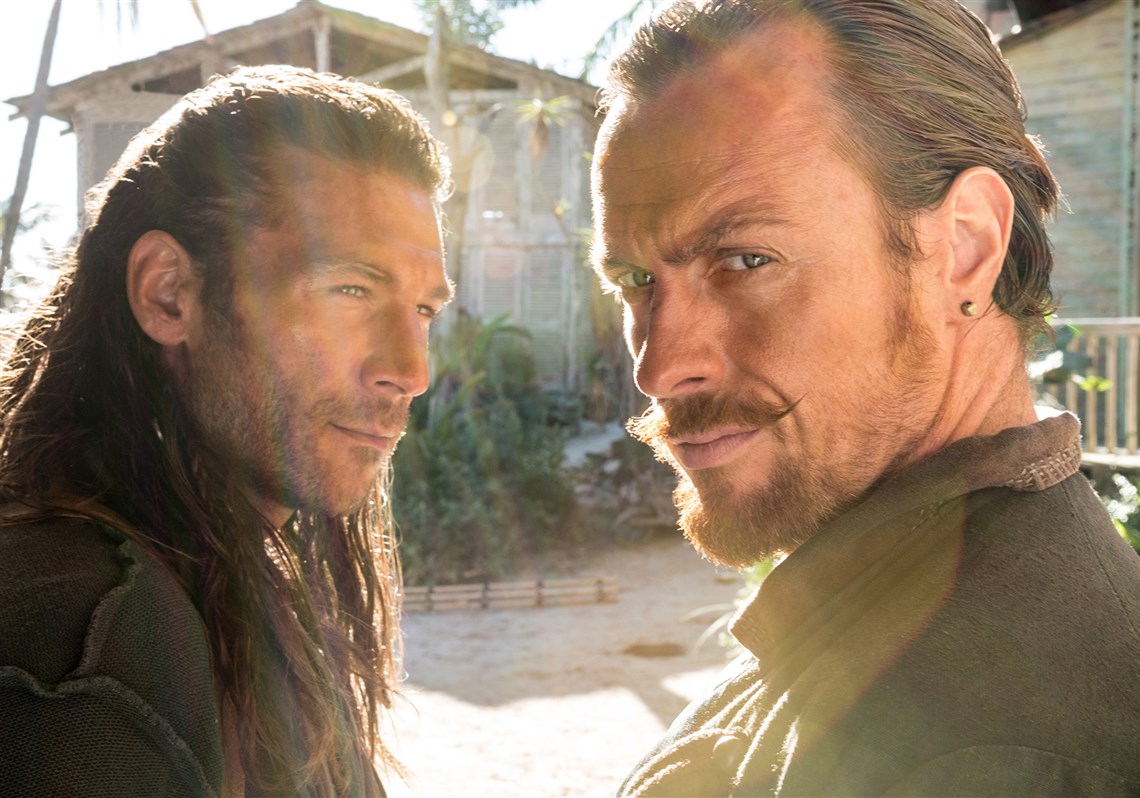
Want to get rowdy… gonna get a little unruly
The result is a mix of high seas action, bedroom intrigue, political maneuvering, and the unavoidable march of time.
While Steinberg and Levine took certain liberties in bending history to suit their narrative — for example, depicting the deaths of some characters differently from how they reportedly happened in reality — they shrewdly do this in service of the show’s theme.
In many interviews, Steinberg and Levine repeatedly stress that very little of our historical knowledge of pirates is based in fact. Rather, it’s based on hearsay and character witnesses who were almost definitely biased in their details. Thus, we can’t truly know what someone like Jack Rackham or Charles Vane was really like… which gives Black Sails the freedom to shift those details and timelines around as necessary.
Because all stories are, ultimately, unprovable legends imperfectly retold, aren’t they?
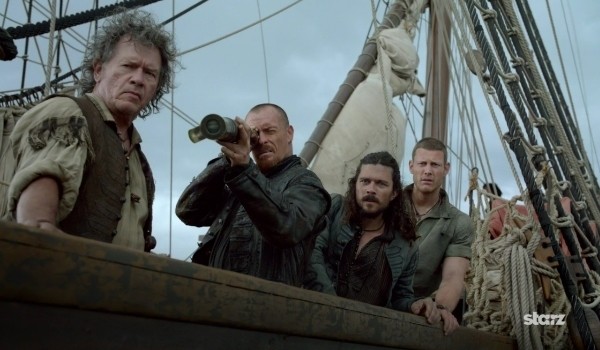
Ladies? Gentlemen? Ring the alarm.
The Plot of Black Sails
Set roughly 20 years before Treasure Island, Black Sails opens with a bang:
Captain Flint and his legendary pirates seize the cargo of a merchant ship from its terrified crew. In the process, they gain a resourceful new crew member — a dashing but self-serving scoundrel named John Silver (Luke Arnold)… who happens to possess the very item that Flint is secretly hunting for: the schedule of the Urca de Lima, a Spanish galleon that carries untold riches.
Over the next four seasons, Flint and Silver will wrestle for control of their ship, their men, their morals, their souls, and their place in history. They’ll travel from the pirate bay of Nassau to the American colony of Charleston, SC. They’ll clash with the Spanish, the British, the Americans, their fellow pirates, the partners they love, and themselves. We’ll come to see both men in a variety of lights, we’ll question their decisions, and we’ll find ourselves in the uncomfortable position of rooting for them even as they do completely reprehensible things, because we understand what they really want.
And by the end, we’ll be treated to a conclusion that’s equal parts satisfying, frustrating, wistful, and optimistic, all at the same time.
None of which would have been possible if not for one thing:
Captain Flint is one of the best-written characters in the past 20 years of television.
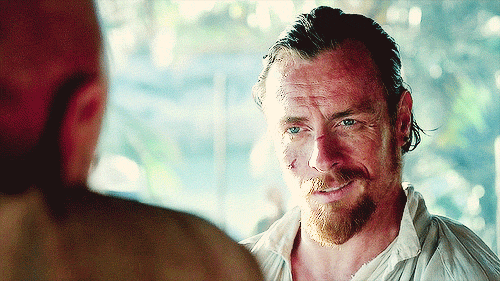
Too dirty to clean my act up
Why Captain Flint on Black Sails Is a Perfect Character
Here’s a cornerstone rule of great storytelling:
The greatest plots are inseparable from character.
Their twists are due entirely to the choices and actions made by the characters as they seek to rectify what they want with what they need. In the best stories, all conflicts — even the seemingly external — are driven by interpersonal conflicts, which all stem from the characters’ struggles to overcome their own inner conflicts and personal flaws.
By that measurement, Captain Flint is a terrifyingly efficient example of character in action.
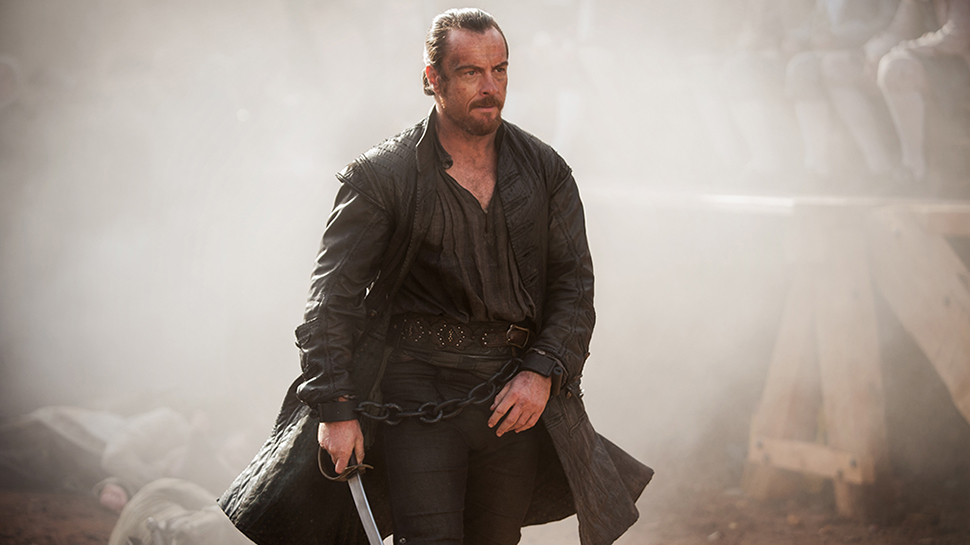
Flint’s External Conflicts
There are three levels of external conflict that drive Black Sails:
- Flint wants the gold from the Urca de Lima
- Flint wants to defeat England at war
- Flint wants to liberate Nassau
These three conflicts nest within one another: Flint needs the gold to finance his war so he can gain Nassau’s independence.
But his high-minded ideals are at odds with pretty much every other character on the show.
Flint’s Interpersonal Conflicts
The vast majority of the pirates do what they do because they like money, and freedom, and occasionally killing someone. They’re not pursuing liberty; they’re getting away with what they can while trying to amass as much power (through fear, intimidation, or brute strength) as possible.
As such, Flint is forced to make and break alliances with nearly every character in Black Sails, always trying to stay one step ahead of people who literally want to kill him.
Not only does he have to outmaneuver rival pirates like Charles Vane (Zach McGowan) and Benjamin Hornigold (Patrick Lyster), and suppress the mutinous instincts of his own crew, but he also has to win nonstop political games with the merchants and gatekeepers who control his ability to profit (and live).
As in the best plots, every choice Flint makes is between one bad outcome and another, but always in pursuit of his ideal goal. One wrong move and he might die; another, and the crew who barely trusts him in the first place could be wiped out completely. And through it all, Silver is there to keep Flint from going off the rails… or to push him out, if need be.
But even this would only be a competent plot without the third ingredient: Flint’s internal struggle.
Flint’s Internal Conflict
Why does Captain Flint want to liberate Nassau?
Why is he willing to do such horrific things — murder, betrayal, war — in pursuit of some seemingly noble cause?
Because everything Captain Flint does is driven by his internal flaw: he’d rather burn the world to the ground than let it tell him what he’s not allowed to be.
And while that may sound like the motivation of every cartoon villain ever, here’s the twist: what the world has decided Captain Flint is not allowed to be is… bisexual.
In the second season of Black Sails, we spend a lot of time in Flint’s head as he flashes back to his life before he became a pirate… back to when he was a naval officer in London, who wanted to pardon the pirates of Nassau and help them to become civilized men once again.
Why?
Because he met a man who had that dream: Thomas Hamilton (Rupert Penry-Jones), a married nobleman who almost had the charisma to convince Parliament that pardoning Nassau’s pirates was a reasonable choice. Thomas wanted them to regain their freedom and have a second chance at life. He believed all men deserved to be forgiven for their transgressions. And when the man who would become Flint fell in love with Thomas, he took up that cause too… until the powers that be learned of their affair and had it ended.
Flint was cast out of England, made a criminal for his passions. So he decided that if they wouldn’t allow him to live the life he’d chosen, he would become the monster they wanted him to be.
Flint wants to liberate Nassau because he wants to realize Thomas’s vision, and thus beat England at its own game. They thought Flint and Thomas could be silenced? Instead, their choice created the worst pirate the world had ever seen, who would stop at nothing until they gave him what he wanted.
And once you understand that side of Captain Flint, he becomes impossible to not empathize with.
How the Choices in Black Sails Lead to Epic Consequences
There are too many storylines and plot twists in Black Sails to detail them all, but here are three examples of how Steinberg and Levine’s deft writing skills turn small choices into big payoffs.
(WARNING: Spoilers ahead for Black Sails)
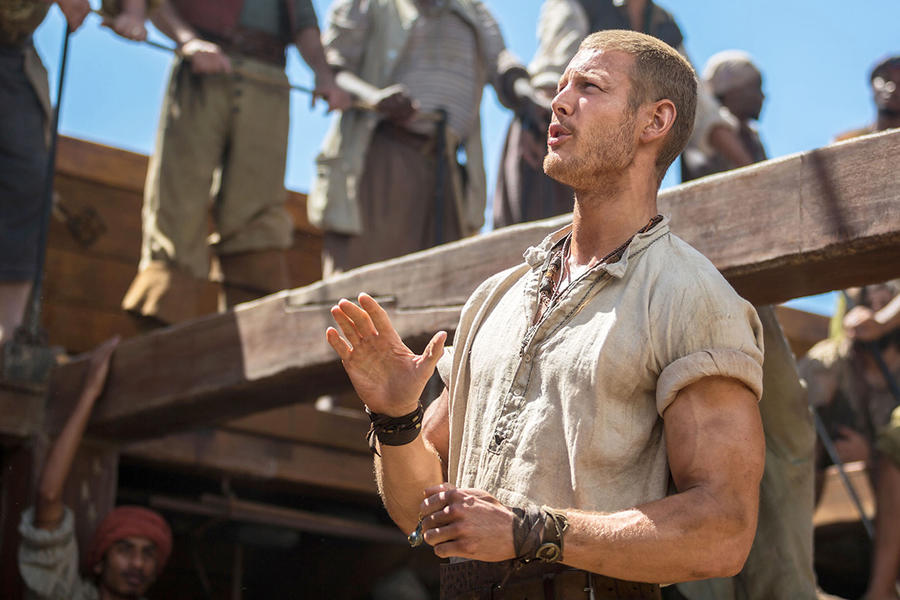
Oh, I’m overdue… Give me some room, I’m comin’ through…
The Rise and Fall of Billy Bones
Flint and his boatswain, Billy Bones (Tom Hopper), have a twisted relationship from the show’s very first episode when Billy, an idealist, is beguiled into helping Flint by lying to the crew that trusts him.
By using Billy in this way to achieve his own ends, Flint starts a ticking clock: Billy spends the rest of the series waiting for justice or karma to do Flint in… and when he finally realizes that’s not going to happen, Billy takes matters into his own hands.
Billy’s choice — to stay behind on Paradise Island and incite Flint’s long-awaited revolution while Flint retreats to prepare a future attack — leads to the creation of Long John Silver’s legend, a rebel uprising that backfires, a treasonous act that undermines the entire pirate alliance, and the final splinter that drives Silver and Flint apart.
And it all happens because, by incorporating Billy into his very first onscreen swindle, Flint showed Billy a side of himself that Billy would spend the next four years desperately trying to erase.
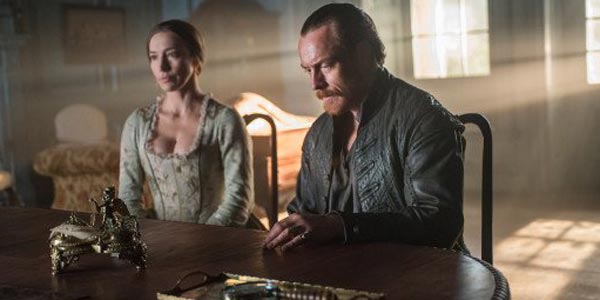
Table dancing, glasses are smashing… no question, time for some action
Old Friendships Die Hard
In season two, Flint and his lover, Miranda Barlow (Louise Barnes) — who’s also Thomas Hamilton’s ex-wife (yes, it’s complicated) — learn that Charles Vane is holding a very important hostage: the daughter of an English magistrate who may have the power to grant Flint his vision of a free Nassau without the need for war.
Flint and Miranda sail to the American colonies, where this magistrate they knew in London has been installed as the governor of South Carolina. Unfortunately, they realize too late that their plan is destined to fail… but luckily (?), Charles Vane followed them to South Carolina to retrieve Flint’s man-of-war ship, which he’d been promised in exchange for handing over the girl. (Flint’s accomplice and Vane’s ex-lover, Eleanor (Hannah New), had freed the girl herself, thus denying Vane his prize, so he was out for revenge.)
But when Vane realizes Flint is certain to die in Charlestown, he decides that a dead Captain Flint would only embolden the British navy to hunt down the rest of the pirates… including him. What Vane does next changes the dynamic of his relationship with Flint — and, in the process, the course of the series. Without Vane’s strategic decision at this crucial moment, the rest of the show never would have happened.
And all because, in a story of men forever giving in to their own worst instincts, the feared Captain Flint proved himself to ultimately be the most honorable man.
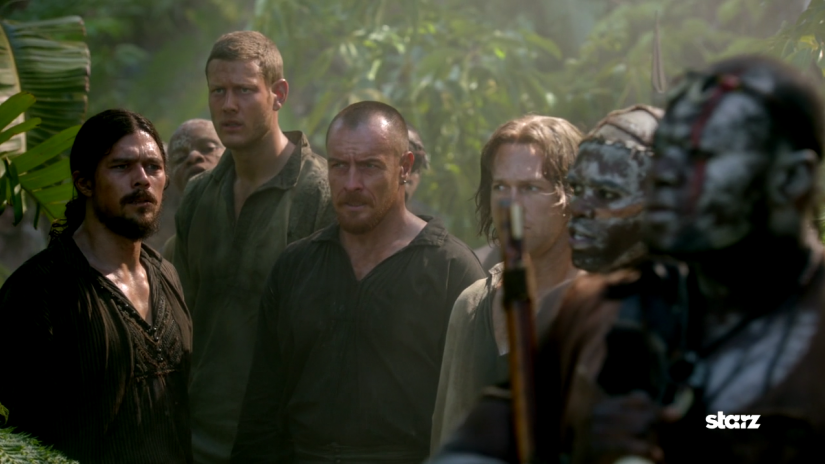
Gonna get my girls, get your boys, gonna make some noise…
Death Before Dishonor
At the beginning of season three, Flint’s crew are offered a choice: a complete pardon by England if they surrender, or certain death if they don’t. Instead, Flint talks them into a third option: evading the ship sent to capture them by sailing directly into a killer storm.
Flint’s evasion tactic works… except that once the storm passes, it takes all measure of wind with it… and Flint’s ship is becalmed for weeks. With no wind and few provisions, the crew nearly starves to death… only to eventually make their way to land on a random island… which, it turns out, is inhabited by former slaves (“maroons”) who’ve built a free colony… and they take the weakened pirates hostage.
Meanwhile, Flint’s long absence during Nassau’s fall opens the door for Blackbeard (Ray Stevenson) to seize power, fracturing the old alliance that Flint had made with Charles Vane and Jack Rackham (Toby Schmitz) and creating a truly dangerous wild card.
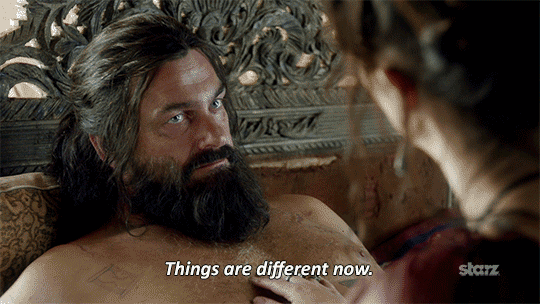
Flint knows he and his men will likely die in captivity on the maroons’ island, so he makes a gamble: he convinces the maroons’ queen to join him in retaking Nassau from the British. Why? Because if they don’t, and Nassau becomes an official British port again, it’s only a matter of time before the colony is overtaken and the maroons are re-enslaved.
Fight now or die later, he suggests. That pitch wins him the alliance he needs to make his ultimate move against the British empire.
And none of it would have happened if Captain Flint hadn’t been able to convince a ship filled with men who’d just been offered a total pardon for their crimes to sail into almost certain death instead.
Now that’s a character.
For all those reasons and dozens more, Captain Flint — and Black Sails — deserve your binge-watching attention. The series is currently available in its entirety on Amazon Prime.
More Posts Like This:
WandaVision’s Biggest Question Gets Deep: Who Are We, Really?
Steve Harrington, Jaime Lannister, and the Secret to Writing a Redemption Arc
What Game of Thrones and The Walking Dead Can Teach Us About Modern Storytelling


2 Comments
Anna Brown · November 23, 2019 at 11:35 am
I just finished this series and think it’s one of the best ever written and like so much of what you said and am commenting for the fun of it— but there’s two points you make that I’d like to challenge: 1. I’m not sure if call flint and silvers relationship “split apart” I think they ultimately find a way to stay true to each other. Even tho silver achieves his ultimate goal. And 2. I don’t think flint is the most moral (tricky word) character. I was surprised to find that the person I felt who came the closest to most moral was Charles Vane. He was always true to himself and his beliefs and kept his promises and kept the bigger picture in mind. And ultimately sacrificed himself for the cause. Anyway. Just for fun :)
Will · May 16, 2018 at 11:38 am
Agreed, top to bottom. One of my favorite quotes from the whole deal was “They paint the world with shadows and tell their children to keep to the light. Their light.” So. Damn. Good.